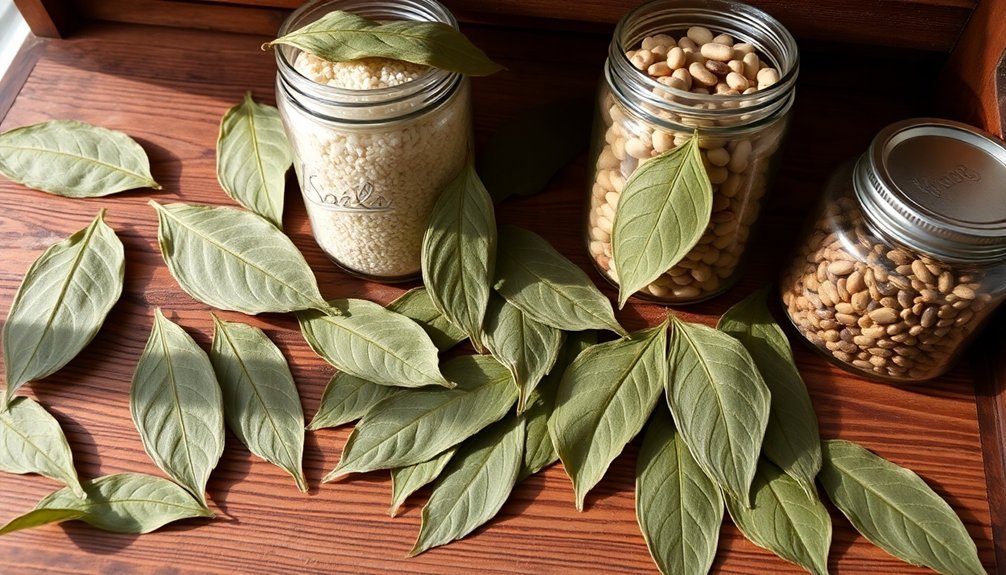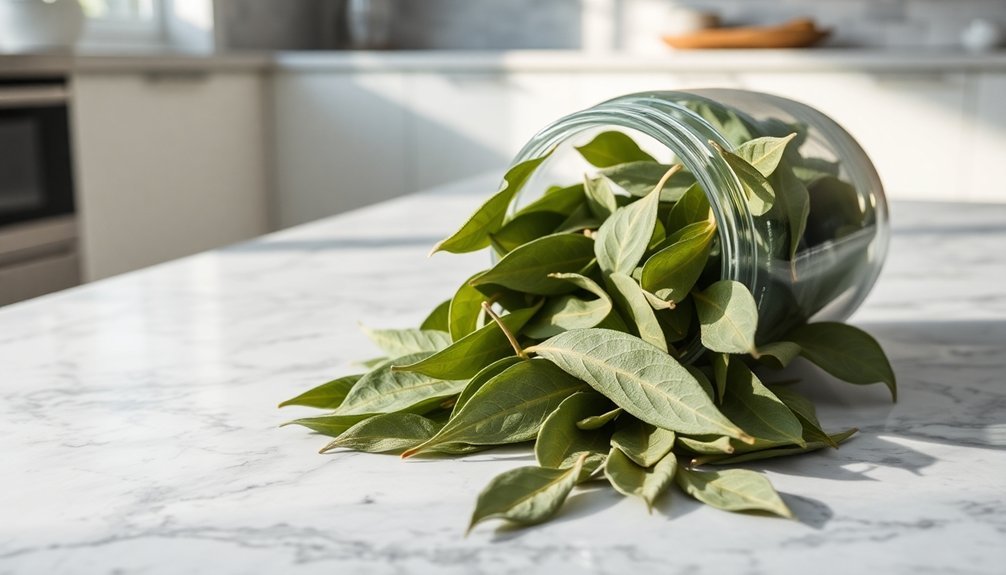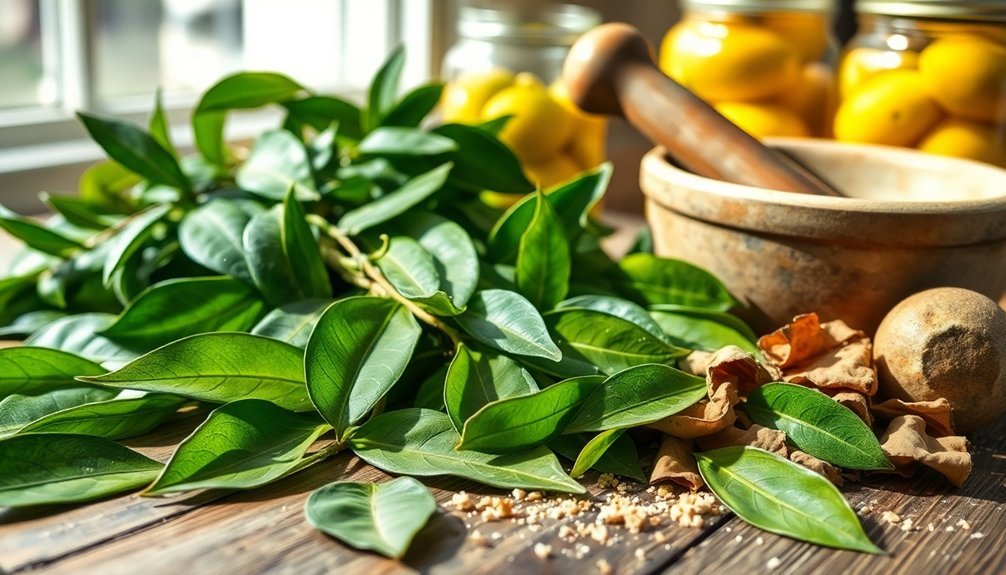You'll find bay leaves are more than just a flavorful herb – they're an ancient food preservation secret still relevant today. Their natural compounds, including essential oils and antimicrobial agents, can extend food freshness by up to 12 hours at room temperature. When you store foods with bay leaves, their antioxidants and natural acids create an environment that fights bacteria and prevents spoilage. You can use them in soups, stews, and even with seafood for both taste and preservation benefits. Understanding the full power of this traditional spice will transform how you keep your food fresh.
The Legacy of Bay Leaves

The allure of bay leaves spans millennia, weaving through the tapestries of ancient civilizations with remarkable significance. You'll find their legacy deeply rooted in Greek and Roman cultures, where these aromatic leaves crowned the heads of victors, poets, and athletes. The very terms you know today as "baccalaureate" and "poet laureate" stem from this ancient practice of recognition.
In ancient Greece, you'd discover the bay laurel's sacred connection to Apollo, immortalized in the myth of Daphne, who transformed into a bay tree. The Egyptians also recognized the leaf's power, incorporating it into their perfumes and using it to combat headaches and fevers.
When you visit ancient healing temples, you'd have found bay trees planted purposefully in their gardens. Medieval Europeans embraced bay leaves as a versatile ingredient, adding them to soups and stews.
You're experiencing a living connection to history each time you use bay leaves in your cooking or medicine. Their significance transcends mere seasoning – they've symbolized love, strength, victory, and courage across cultures.
From their role in Ayurvedic medicine to their presence in modern aromatherapy, bay leaves continue to bridge ancient wisdom with contemporary practices.
Natural Food Preservation Power
Beyond their aromatic appeal, bay leaves serve as powerful natural preservatives in your kitchen arsenal. Their essential oils, including eucalyptol, terpenes, and methyleugenol, work actively to protect your food from spoilage. You'll find these compounds particularly effective in preventing mold growth and maintaining food freshness through their natural antioxidant properties.
When you're canning foods at home, bay leaves become your reliable preservation partner. Add 1-2 leaves per half-pint jar to enhance both flavor and preservation power. Consider using fresh bay leaves for a milder and more pleasant flavor profile. You'll notice they work exceptionally well in pressure canning, where their complex aromas withstand high temperatures while harmonizing with other ingredients.
They're especially useful in preserving vegetables, pickles, and tomato-based products.
You can also harness bay leaves' natural pest-repelling abilities in your pantry. Scatter them among your stored foods to keep meal moths, flies, and cockroaches at bay. The leaves' preservative qualities don't just stop at food – they'll help maintain moisture levels and prevent mold growth in storage areas.
Whether you're using fresh or dried leaves, you'll get both flavor enhancement and natural preservation benefits, making bay leaves an indispensable ingredient in your food preservation efforts.
Adding Bay Leaves to Storage

Integrating bay leaves into your food storage system offers a simple yet effective strategy for pest control and preservation. Since ancient times, bay leaves have been prized for their protective properties. You'll find that both Turkish and California bay leaves work well, though Turkish varieties (Laurus nobilis) are typically preferred for their ideal balance of aroma and preservative properties.
To implement this natural preservation method, you can add bay leaves directly to your storage containers or create small muslin pouches for easier handling. Place them throughout your dry goods like rice, beans, and grains, ensuring even distribution for maximum effectiveness.
You'll want to use several leaves for larger storage containers, while smaller containers may only need one or two. For best results, store your bay leaf-protected foods in airtight containers away from direct sunlight. You can combine this method with oxygen absorbers for enhanced preservation.
Don't forget to check your stored goods regularly and replace the bay leaves periodically to maintain their pest-repelling properties. Choose high-quality, pale green leaves without blemishes, and you'll find they're particularly effective for long-term storage without affecting your food's flavor or nutritional content.
Scientific Evidence Behind Preservation
You'll find solid scientific backing for bay leaves' preservative powers through extensive research on their antimicrobial compounds, including flavonoids, terpenoids, and essential oils that actively fight harmful bacteria.
These natural compounds work by disrupting bacterial cell membranes, denaturing proteins, and inhibiting enzyme activity, making them particularly effective against food-spoiling microorganisms and certain drug-resistant strains.
Food safety studies have proven that bay leaf extracts can extend shelf life up to 12 hours in stored fish and effectively protect against foodborne pathogens when used in packaging materials or direct food applications.
Antimicrobial Properties Research
Drawing from extensive scientific research, bay leaves demonstrate remarkable antimicrobial properties that make them valuable for both food preservation and medicinal applications. You'll find they're particularly effective against Gram-positive bacteria, with their extracts showing stronger activity than tetracycline in some cases. The compounds work primarily against bacteria like Staphylococcus aureus and Streptococcus faecalis, though they're less effective against Gram-negative strains.
The antimicrobial action occurs through multiple mechanisms. You're getting protection through flavonoids that form hydrogen bonds with bacterial proteins, while tannins denature cell membrane proteins. The essential oil's high 1,8-cineole content and terpenoids target bacterial cell walls by disrupting their transmembrane proteins.
Bay leaves don't stop at bacteria – they're also effective against various fungi, including Mucor hiemalis and Candida species.
You can use them practically in food preservation, where a 7% concentration of bay leaf extract considerably reduces bacterial counts. When you're looking to extend food shelf life naturally, bay leaf extracts in packaging materials or direct application can effectively control microbial growth without synthetic preservatives.
Natural Preservation Compounds
Natural compounds in and around bay leaves provide scientifically proven preservation capabilities through multiple mechanisms of action.
These compounds work similarly to other plant-based preservatives, disrupting microbial cell walls and interfering with metabolic processes that lead to food spoilage. You'll find that bay leaves contain essential oils that contribute to their preservative properties, though their effect is relatively mild compared to other natural preservation methods.
When you're looking at natural preservation compounds, you'll discover they generally work through these primary mechanisms:
- Antimicrobial action through bioactive peptides and essential oils that prevent bacterial growth
- Antioxidant properties from flavonoids that protect foods from oxidative damage
- pH modification through natural acids that create an inhospitable environment for harmful microorganisms
You can combine bay leaves with other natural preservatives like salt, vinegar, or citric acid to enhance their effectiveness.
This approach aligns with growing consumer demand for natural preservation methods, as they're generally recognized as safe and offer fewer side effects than synthetic alternatives.
While bay leaves alone won't preserve your food indefinitely, they're part of a broader spectrum of natural compounds that can help extend food freshness.
Food Safety Studies
Through rigorous scientific studies, bay leaf preservation capabilities have been thoroughly documented, particularly in seafood applications. You'll find compelling evidence in research focused on scad fish, where scientists used varying concentrations of bay leaf extract under controlled conditions. The studies revealed that a 7% bay leaf extract solution provided ideal bacterial inhibition for up to 12 hours at room temperature.
When you examine the research methods, you'll notice they tracked multiple parameters including bacterial count, pH levels, water content, and organoleptic values. The results weren't just impressive – they were statistically validated through ANOVA and Duncan's Multiple Range Testing.
What makes bay leaves so effective is their rich composition of antibacterial compounds like flavonoids, terpenoids, and tannins.
You'll also see bay leaf extracts performing well in modern food protection applications. They're now being incorporated into protective coatings and polyvinyl alcohol films. These applications don't just fight bacteria – they're also effective at blocking UV radiation and reducing mass loss in fresh produce.
The science shows that bay leaves aren't just a traditional preservative; they're a verified food safety solution.
Best Storage Practices

- Freeze fresh leaves in small batches within freezer-safe bags for up to three months.
- Store dried leaves in an airtight container in a cool, dark place for up to two years.
- Extend shelf life to five years by freezing dried leaves in an airtight container.
If you're drying your own leaves, make certain they're completely bone dry before storage.
Place them on a baking tray between parchment sheets in a warm, dry place for 6-7 days, or use your oven's lowest setting with the door slightly open.
Common Preservation Applications
Time-tested preservation methods guarantee you'll always have flavorful bay leaves on hand. You can dry them using a dehydrator at 110 degrees for 5-7 hours, placing leaves on mesh trays with stems facing center.
For natural drying, lay them on kitchen paper or cheesecloth, turning occasionally, or hang entire branches in a warm, dry area away from direct sunlight.
To keep bay leaves fresh, place them in a flower vase with water, cutting stems at a 45-degree angle and removing lower leaves. You'll extend their life by vacuum sealing and refrigerating them, or storing them in a cool, dark place.
If you're planning long-term, consider growing a bay laurel tree indoors, which provides year-round access to fresh leaves.
You can also preserve bay leaves' flavor through infusion. Boil them briefly in water or broth to create a concentrated liquid for soups, marinades, and stocks.
Add the leaves during the final 5-10 minutes of cooking to achieve prime flavor without bitterness. When preserving the dried leaves, store them whole in an airtight container to maintain their potency.
Modern Kitchen Storage Methods

Building on traditional preservation methods, modern storage techniques offer practical ways to maintain bay leaves' quality. You'll find that airtight containers like glass jars or zip-lock bags are your best options, as they prevent the essential oils from escaping.
When storing your bay leaves, avoid paper bags which can lead to flavor loss and choose a cool, dark location away from your stove and sink.
For ideal storage results, follow these key steps:
- Clean and inspect your bay leaves for debris, washing them under cool water if needed.
- Place them in an airtight container, labeled with the storage date.
- Store the container in a pantry or spice cabinet away from heat sources.
If you're looking for long-term preservation, freezing offers an effective solution. You can either freeze bay leaves in ice cube trays with water or store them in airtight freezer bags.
While frozen leaves might lose some potency, they'll remain usable for up to a year. Remember to check your stored bay leaves periodically, replacing them when they lose their vibrant green color or distinctive aroma.
Frequently Asked Questions
Can Bay Leaves Be Used to Flavor Beverages Besides Tea?
Yes, you can use bay leaves to flavor various beverages! Try adding them to marinara-based drinks, broths, infused water with honey and lemon, or spiced drinks combined with cinnamon for unique, aromatic flavors.
How Long Do Fresh Bay Leaves Stay Aromatic After Being Picked?
You'll find fresh bay leaves maintain their aromatic qualities for 1-2 weeks when refrigerated properly. If you freeze them, they'll stay fragrant for up to 6 months, but they'll lose potency over time.
Are There Different Varieties of Bay Leaves With Distinct Flavors?
Yes, you'll find distinct varieties like Turkish bay leaves with subtle, earthy flavors, California bay leaves with intense minty notes, and Indian bay leaves commonly used in garam masala and other spice blends.
Can Bay Leaves Be Grown Successfully Indoors as Houseplants?
Yes, you can grow bay laurel successfully indoors near a sunny window. You'll need well-draining soil, proper watering, and temperatures between 60-75°F. Don't forget to maintain good humidity levels.
Do Mediterranean and California Bay Leaves Have the Same Culinary Properties?
No, they're quite different. You'll find Mediterranean bay leaves are milder and more versatile, while California bay leaves are considerably stronger and more pungent. You'll need to use California varieties more sparingly.
In Summary
You've discovered an ancient secret that's still relevant today – bay leaves aren't just for flavoring your food. By adding these powerful leaves to your storage containers, you'll naturally preserve your pantry items and keep pests away. Whether you're storing grains, flour, or dried goods, incorporate this time-tested method into your modern kitchen routine. It's a simple, natural solution that connects you to centuries of food preservation wisdom.





Leave a Reply